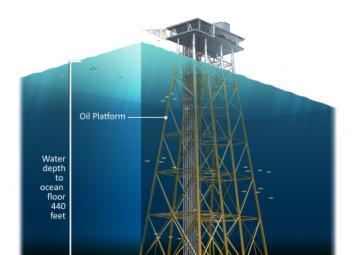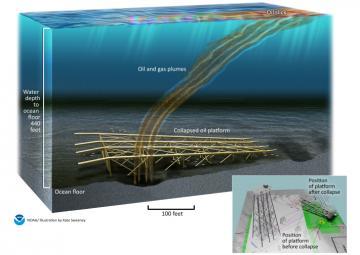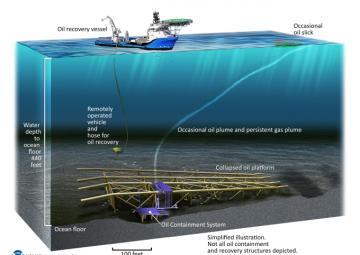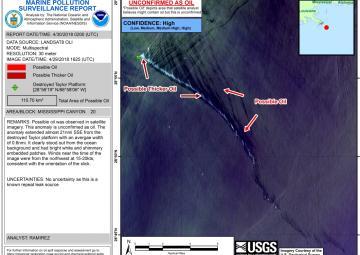Scientific advancements in oil spill containment prove successful 1 year after implementation
U.S. Coast Guard sent this bulletin at 04/27/2020 03:44 PM EDT
| News Release |
U.S. Coast Guard Headquarters |
Scientific advancements in oil spill containment prove successful 1 year after implementation
Editor’s note: For high resolution before and after satellite images of the spill, and graphics of the Rapid Response Solution subsurface system, click on the thumbnail images below.
 |
 |
 |
 |
 |
WASHINGTON, D.C. – An innovative sub surface oil containment and recovery system, installed in April 2019 over a damaged oil platform in the Gulf of Mexico, is successfully preventing more than 1,000 gallons of oil per day from entering the environment. Scientific research and lessons learned following the Deepwater Horizon oil spill have allowed the development of unique oil spill response systems such as this to help protect the maritime environment from future threats.
In 2004 during Hurricane Ivan the Taylor Energy Mississippi Canyon 20 (MC20) oil platform toppled creating an ongoing flow of oil into the Northern Gulf of Mexico. Scientists from multiple government agencies and academic institutions, conducted cutting-edge studies that determined the location, source, and amount of oil and gas emitting from the site.
Utilizing remote sensing technologies such as drones, satellites, and underwater vehicles in combination with on-site in-situ sampling and chemical analysis, scientists were better able to characterize the oil release.
Two separate studies conducted in 2017 determined that the oil and gas were discharging from multiple plumes in a discrete location rather than over a wide area. In 2018, the Bureau of Safety and Environmental Enforcement and the National Oceanic and Atmospheric Administration undertook a follow-up study to determine the chemical characterization of the release, and to generate a flowrate (amount of oil and gas spilling in a given period of time) estimate for the site.
These studies helped determine that oil was leaking from the damaged infrastructure and could be contained, and that more than 1,000 gallons of oil per day was being released. This was substantially greater than the previously asserted 3-5 gallons per day.
The United States Coast Guard assumed partial control of the Taylor Energy oil spill response after repeated past attempts failed to stop, or contain, the flow of oil in the years since the platform with 25 producing wells were toppled and buried in sediment.
The Coast Guard, with support from the National Oceanic and Atmospheric Administration and the Bureau of Safety and Environmental Enforcement, oversaw the design, installation and operation of a Rapid Response Solution (RRS) subsurface system designed by the Louisiana based Couvillon Group.
The containment and collection system was developed and implemented in only 5 months in order to quickly stem the flow of oil. The system has recovered more than 375,000 gallons of oil since it was installed. Environmental protection continues, with the Coast Guard overseeing continuous oil collection and containment system maintenance.
These scientific successes are made possible through the collaborative efforts of the interagency team of oil spill responders and scientific experts. The Coast Guard and National Oceanic and Atmospheric Administration will continue to support the Bureau of Safety and Environmental Enforcement efforts to use sound science to ensure that the Taylor Energy wells are properly plugged and a permanent solution is reached.
Media seeking opportunities to highlight scientific achievements and advancements on oil spill response, as they pertain to the federal response to the Taylor Energy oil spill, are encouraged to contact the below points of contact.
Coast Guard Public Affairs: (202) 372-4630 mediarelations@uscg.mil
NOAA Public Affairs: (202) 236-6662 jerry.slaff@noaa.gov
BSEE Public Affairs: (504) 400-7864 Karla.Marshall@bsee.gov
Additional materials expanding on the scientific processes noted above can be found at the following links.
NCCOS Scientists Publish Flow Rates for 14-year-long Oil Spill in Gulf of Mexico (video)
-USCG-

